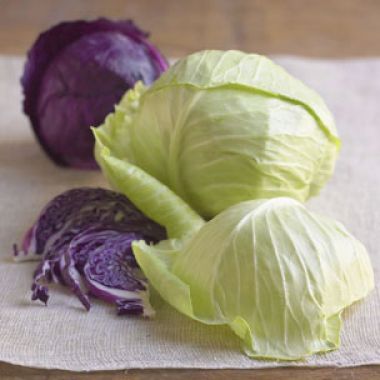
Fresh cabbage leaves may be pale green or red, with green cabbage (also called Dutch white) the most plentiful. Although cabbage is sold fresh year-round, this vegetable is at its best during the cold autumn and winter months.
Cabbage is the primary ingredient in two popular preparations, coleslaw and sauerkraut. Whole leaves can be boiled or blanched until pliable and then stuffed and steamed. Whole cabbages can be stuffed as well, with a flavorful mixture tucked between the leaves. Chopped cabbage is added to soups and braises.
Selecting
Buy firm, heavy heads of green, red and savoy cabbage with closely furled leaves. An average head weighs about 2 pounds. Color is an indication of freshness. For example, green cabbages stored for too long lose pigment and look almost white. To ensure freshness, check the stem ends of cabbage heads to make sure the stem has not cracked around the base, which indicates undesirably lengthy storage. Chinese cabbage leaves should be crisp, unblemished and pale green with tinges of yellow and white.
Storing
Refrigerate heads of green and red cabbage for up to 2 weeks, savoy and Chinese cabbage for 5 or 6 days. If you want to eat the cabbage raw, do so within 3 or 4 days. Do not cut or shred cabbage until you are ready to use it. Store the unused portion intact, wrapped in plastic, and use within 2 days.
Preparing
Pull off and discard any wilted outer leaves and cut the core from the head, either by cutting the head in half or quarters and slicing the core from the center, or by cutting around the core from the base.
Shred or slice cabbage for salads (a food processor makes quick work of the task).
Nothing combats the odor of cooking cabbage, despite old wives' tales about dropping a whole walnut or a chunk of bread into the cooking pot. Cooking it quickly helps, but a kitchen exhaust fan is the best defense.
Adapted from Williams-Sonoma Kitchen Companion (Time-Life Books, 2000).
Related Recipes:
- Brussels Sprouts Gratin with Caramelized Shallots →
- Purple Cabbage Slaw with Raisins →
- Savoy Cabbage and Turnips →
- Coleslaw →
- Fast Fish Tacos →
- Brussels Sprouts & Butternut Squash with Bacon Vinaigrette →
- Sausages with Warm Cabbage Salad →
- Braised Noodles with Chicken and Vegetables →
- Roast Duck Legs with Savoy Cabbage (Cuisses de Canard au Chou) →
- Pork-Stuffed Cabbage Rolls →
- Beet, Cabbage & Mushroom Borscht →
- Dungeness Crab Cakes with Cabbage Slaw →
- Roasted Pork Tenderloin with Sweet and Sour Cabbage →
- Fish Tacos with Cabbage Slaw and Avocado Crema →
- Sautéed Squash and Purple Cabbage →
- Chicken Fajitas with Savoy Cabbage Slaw →
- Corned Beef and Cabbage →












